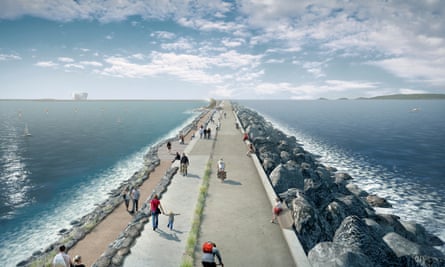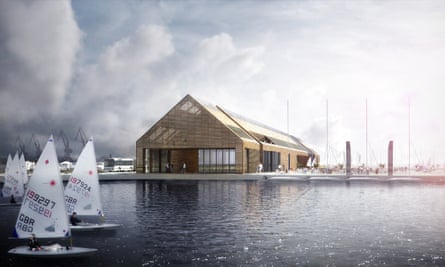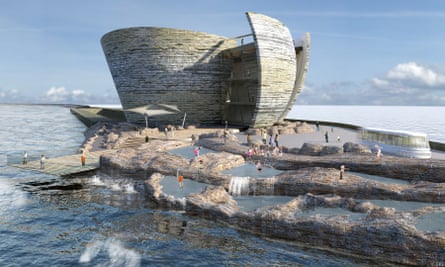Tyrone O’Sullivan is not an obvious evangelist for the vast Swansea Bay tidal lagoon project, lauded by its developers as world leading but dismissed by one critic as Britain’s “pottiest ever” renewable energy project.
The 69-year-old is, after all, chairman of a local coal mining company and a former flying picket during the miners’ strike in 1984, and can happily describe environmentalists as “a pain in the arse”.
But sitting in his comfortable chalet near the seaside village of Mumbles in south-west Wales, O’Sullivan is keen to extol the virtues of developing tidal power close to Wales’s second largest city.
“The scheme will be spectacular. It would be the equivalent of the Sydney Opera House or the London Eye for us even if it did not produce any electricity, which it certainly will,” argued the former branch secretary of the National Union of Mineworkers.
O’Sullivan, partially disabled from a lifetime of extracting coal underground, is talking about the £1bn sea scheme that will require the building of a six-mile sea wall and the installation of 16 underwater turbines.

Renewable energy supporters and coal enthusiasts are not easy bedfellows given the former is basically being subsidised to replace the latter, albeit in a bid to cut carbon and tackle global warming.
O’Sullivan is particularly keen on the 1,900 construction jobs, but it is a far cry from a coal-fired power station – it would provide a sailing and visitor centre as well as enough power for 155,000 homes.
“I am not convinced by wind energy and I hate [low] prices for electricity when I get low prices for our coal but I am so excited for what it [the tidal lagoon] will bring to Swansea and my grandchildren,” he said, pointing to a small girl cooking in the kitchen with his wife, Elaine.
It is the same across town at the headquarters of Neath Port Talbot council, where its chief executive, Steve Phillips, said there is huge local support for the former coal and steel region becoming a leader in marine power.
“We have not had an opportunity like this for 20 or 30 years. We have seen Cardiff benefit from the redevelopment of its bay area and we similarly want to have windows for investors to peer through. That is what the new university campus here provides and what a Swansea lagoon project would do,” he argued.
The project would take three years to build but have a design life of 120 years beyond that. Electricity would be generated by 320MW-capacity turbines propelled by the tide.
The scheme is billed as a world first, but a similar – though different – tidal scheme has operated for 45 years at La Rance in north-western France.
The Welsh secretary, Stephen Crabb, is unsurprisingly a fan but so is the prime minister, David Cameron, according to Mark Shorrock, chief executive of Tidal Lagoon Power, and the man at the centre of the scheme.
Although the project was in the Conservative party manifesto, at a time when the government has been taking an axe to subsidies provided for solar and wind power, there are many who believe the Swansea Bay site will never be anything but a beach.
Mandarins from the Department of Energy and Climate Change (DECC) and the Treasury are poring over the details before deciding whether it should be funded though a ‘contract for difference’ scheme.
The cost of lagoon power – a predicted £168 per MW/hour – is considerably higher than for offshore wind, or the £92.50 for nuclear.
The project has already been dubbed potty and the Daily Mail has predicted it is in line for the chop – the newspaper’s columnist, Christopher Booker, argued that Swansea would produce “easily the most expensive electricity in the world”.
But Shorrock, who claims to have already spent £26m, including £7m of his own money, on the scheme, is confident he can defy the sceptics and get the green light from the government.

Although building Swansea Bay will require a high subsidy, Shorrock believes follow-on lagoon projects at Cardiff and Newport could shrink the power price to below £100 per MW/hour.
“Add a single full-scale project to the pilot and the nation’s first two tidal lagoons are, even in their early years, producing cheaper power than most other low-carbon generators in the country,” he said.
“For less than 1% of the UK’s annual subsidy spend, the Swansea Bay tidal lagoon gives you a scalable blueprint for a secure, long-lived power supply that is low in cost and carbon. And you seed a new global industry here in the UK. That’s incredible value.”
The ebullient 45-year-old claims to be 99.9% confident of getting the go-ahead on subsidies from the DECC before Christmas, hoping it would be too embarrassing at this stage to say no.
But behind the public bravado, Shorrock is less sure. Friends of his told the Guardian that the green entrepreneur suffers bouts of fear that the government could yet “pull the rug from under him”.
Shorrock, a former filmmaker, has plenty of other arguments as to why Swansea Bay makes sense – even for Tory ministers who are slashing subsidies on renewable energy.
He stresses the potential for a massive UK supply chain, even though it is the British arm of a US-based firm, GE, that is overseeing the turbine manufacturing, and a Chinese company that will do the dredging and construct the sea wall.
Sitting in a cafe overlooking Swansea docks, Shorrock said he wants Swansea Bay up and running in 2019-20, with larger schemes in Cardiff and Newport by 2022-23 and, if possible, more after that.
He is already looking into plans to build storage schemes that would enable Swansea Bay power to be available for supply around the clock.

Shorrock said huge institutional equity investors, such as Prudential, and those committed to buying some of the power, including Good Energy, would not attach their names to the project if it was a potty, no-hope scheme.
The fast-talking Shorrock is a persuasive salesman with a track record in pulling off wind and solar schemes, but he has also made the odd blunder. A meeting meant to reassure Cornish householders over plans for his private company, Shire Oak, to reopen a quarry near the Lizard peninsula to provide rock for the Swansea Bay breakwater, only seemed to reinforce opposition.
There has also been a complaint made to the government by a company about how the dredging and sea wall contract was handled, and concerns about the cosy relationship between Shorrock and Good Energy – Shorrock was until recently a paid adviser to Good Energy, which is run by his wife, Juliet Davenport.Despite all this, Shorrock seems to have almost single handedly built up huge momentum for Swansea Bay, not least by plugging the British innovation line.
“The holy grail for everyone has always been a predictable renewable power,” he said. “Equally, it is time for us as an engineering and seafaring nation to show global leadership again. It’s 100-odd years since Isambard Kingdom Brunel, but our time has come again.”
